5 key facts about this project
This architecture represents a response to contemporary urban challenges, prioritizing sustainable practices and user experience. It combines efficiency with elegance, making it suitable for [specify the function: residential, commercial, cultural, etc.]. By addressing both practical requirements and aspirational ideals, the project stands as a testament to how thoughtful design can enhance daily life.
Among the notable aspects of this design is its spatial organization. The layout includes a series of interconnected areas designed to facilitate movement and interaction. The inclusion of open spaces promotes a sense of community, while private areas offer retreat and contemplation. Large windows and strategic openings allow natural light to flood interior spaces, reducing the need for artificial lighting and establishing a connection to the outdoors.
Materials chosen for the construction of this project play a vital role in its overall impact. Concrete forms the primary structural element, providing durability and stability, while expanses of glass introduce transparency and fluidity to the design. The careful selection of materials, such as wood, which brings warmth and texture, demonstrates a commitment to sustainability and local sourcing. Each element has been purposefully selected to not only serve aesthetic functions but also contribute to the energy efficiency of the building.
The project incorporates several innovative design approaches that set it apart. For instance, its integration of green technologies, such as solar panels and rainwater harvesting systems, is seamless yet effective, attesting to the project’s commitment to reducing its environmental footprint. The roof design, featuring vegetation and natural materials, enhances insulation while promoting biodiversity.
Furthermore, the relationship between the building and its context is carefully considered; it responds to local climate conditions and cultural narratives, allowing it to resonate with residents and visitors alike. Attention to detail is evident in the thoughtful placement of communal spaces designed for gatherings and events, embodying the project's intent to foster social interaction and cultivate a sense of belonging within the community.
As such, this architectural design is not just a standalone structure but a vital component of the locality. It encourages exploration and interaction among its users while standing as a model for responsible and community-focused development. Those interested in delving deeper into this project are encouraged to explore the architectural plans, sections, designs, and overall ideas that underpin its creation. Each element contributes significantly to understanding how this architecture achieves its goals and reflects the values of its environment, laying the groundwork for future innovations in design and sustainability.


























